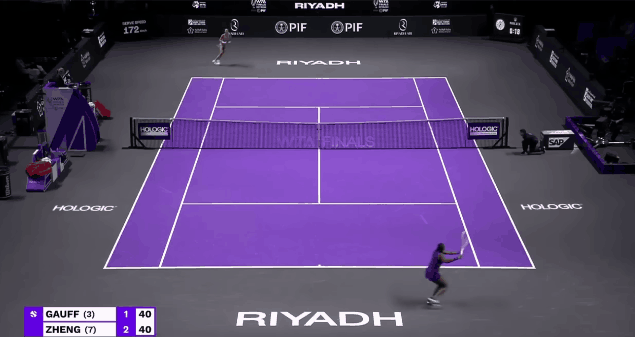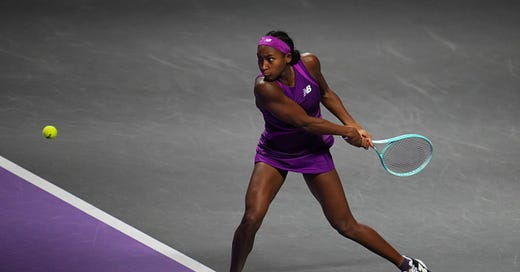Gauff vs Zheng: Riyadh Final Analysis
Return strategy, longer rallies, missed opportunities, momentum swings
Gauff def. Zheng 3-6, 6-4, 7-6(2).
Coco Gauff claimed her maiden WTA Finals title on Saturday evening, staging a dramatic comeback in just over 3 hours against Zheng Qinwen in an absorbing 3-set battle. In the process, Gauff became the youngest WTA Tour Finals champion since Maria Sharapova in 2004, extending her finals record on hardcourt to a record 8-0, and her overall finals record to 9-1.
Let’s get into the analysis behind Gauff’s massive win.
Return strategy
One of the driving factors in Gauff’s win was her returning, particularly on Zheng’s second serves. Gauff was able to generate a quantity of high-quality returns over the match, with most of them directed centrally.
As can be seen on this graphic below – shown early in the second set – 95% of Gauff’s second serve returns to that point were directed through the middle of the court:
It proved an effective strategy – Zheng won only 39% (18/46) of second serve points over the course of the match. Comparatively, across all of Zheng’s other WTA Finals matches, her next lowest second serve points won percentage sat at 47%:
Here are some examples below:


Gauff wins the battle in longer rallies
Gauff had a notable advantage against Zheng in the longer rallies on Saturday – she won more points for rallies of 7-9 shots and rallies of 10+ shots:
A notable reason for this advantage in longer rallies was Gauff’s ability to play the percentages, opting at times to simply get balls back in play – alongside her ability to cover the court efficiently, pouncing on any shorter balls from Zheng.
A couple of examples below:


However, Zheng also contributed to Gauff’s longer rally advantage - she missed some big opportunities on key points…
Zheng’s missed opportunities
It’s no secret that Zheng’s forehand is a serious weapon on the WTA Tour – she’s used it to great effect this year. However, her forehand was a hit-and-miss over the course of the match.
In the first set, Zheng was able to dictate some rallies with it, pinning Gauff back behind the baseline and winning points. However, in the third set and tiebreak, Zheng went for too much on the forehand wing, resulting in a spate of costly unforced errors. In particular, there were some key points in the match where Zheng had the point on her racket, and on her FH, and squandered the opportunities.
In the first example below, deep in the third set and serving to win the match, Zheng hits a great first serve, inducing the short return from Gauff. Zheng gets to it with plenty of time, and simply needs to get the forehand cross-court for a winner. Instead, she mishits the forehand, blasting it long and leaving herself vulnerable to two break points:
A similar story emerges early in the second set tiebreak. Zheng gets the rally on her terms with a great off-angle backhand, and gets a short reply from Gauff. Zheng loads up on the forehand, and has most of the court at her disposal, but she just goes for a little too much and misses. Fine margins, but instead of keeping it at a single mini-break, Zheng now goes down 3-0 early in the tiebreak, down the double mini-break:
Zheng also had some trouble at the net against Gauff. On several occasions, some of which have already been shown above, Zheng was not able to get enough on her volley, or missed it altogether:

Momentum swings and mental toughness
The third set was a rollercoaster, with momentum swinging heavily between Gauff and Zheng. While it was Gauff who ended up on top, showcasing her impressive mental toughness, Zheng also fought valiantly.
It was Zheng who took the third set by the horns through the early and middle stages. In fact, Zheng was only two points away from clinching the title at 3-5. But, as ever, tennis is a game of fine margins and Gauff held her nerve, aided by some fortune in the form of a favourable net cord at 30-30 in the game. The net cord was a big (but not decisive) turning point in the set – Gauff slowly regained momentum from this point:
It was then Gauff’s turn to tighten the screws. She set up two championship points at 6-5 15-40, but Zheng pulled out a clutch +1 forehand FH at 15-40, before hustling to a tricky ball at 30-40 to reach deuce. The forehand at 15-40 for the +1 winner was huge:
However, from that point on, it was all about Gauff. Resetting and forgetting about the championship points that had come and gone, she dominated the final set tiebreak, winning it 7-2, and clinching a famous win in the process.
Overall thoughts
A fitting contest to end another jam-packed schedule on the WTA Tour. Both players had the match on their racquets at various stages, but it was Coco Gauff who managed to find a little bit extra in the final set tiebreak.
Gauff was much more willing to play the percentages in the later stages of the match, getting as many balls back into play as possible. In contrast, Zheng continued to try to blast winners and played with a lot less margin for error. Zheng’s aggressive approach didn’t pay dividends – she hit too many unforced errors, and had several other missed opportunities that she would have put away on another day.
Gauff continues to show her mental fortitude and composure in big matches – she has once again reinforced her ability to challenge, and beat, the best players on tour when she has all of her weapons firing. She has a very bright future ahead.
Much credit must be given to Zheng’s season too – not only did she clinch Olympic Gold this year, but she has also entrenched herself at the top end of the WTA tour and will be in strong contention for a maiden grand slam title in 2025.
Thanks for reading!













